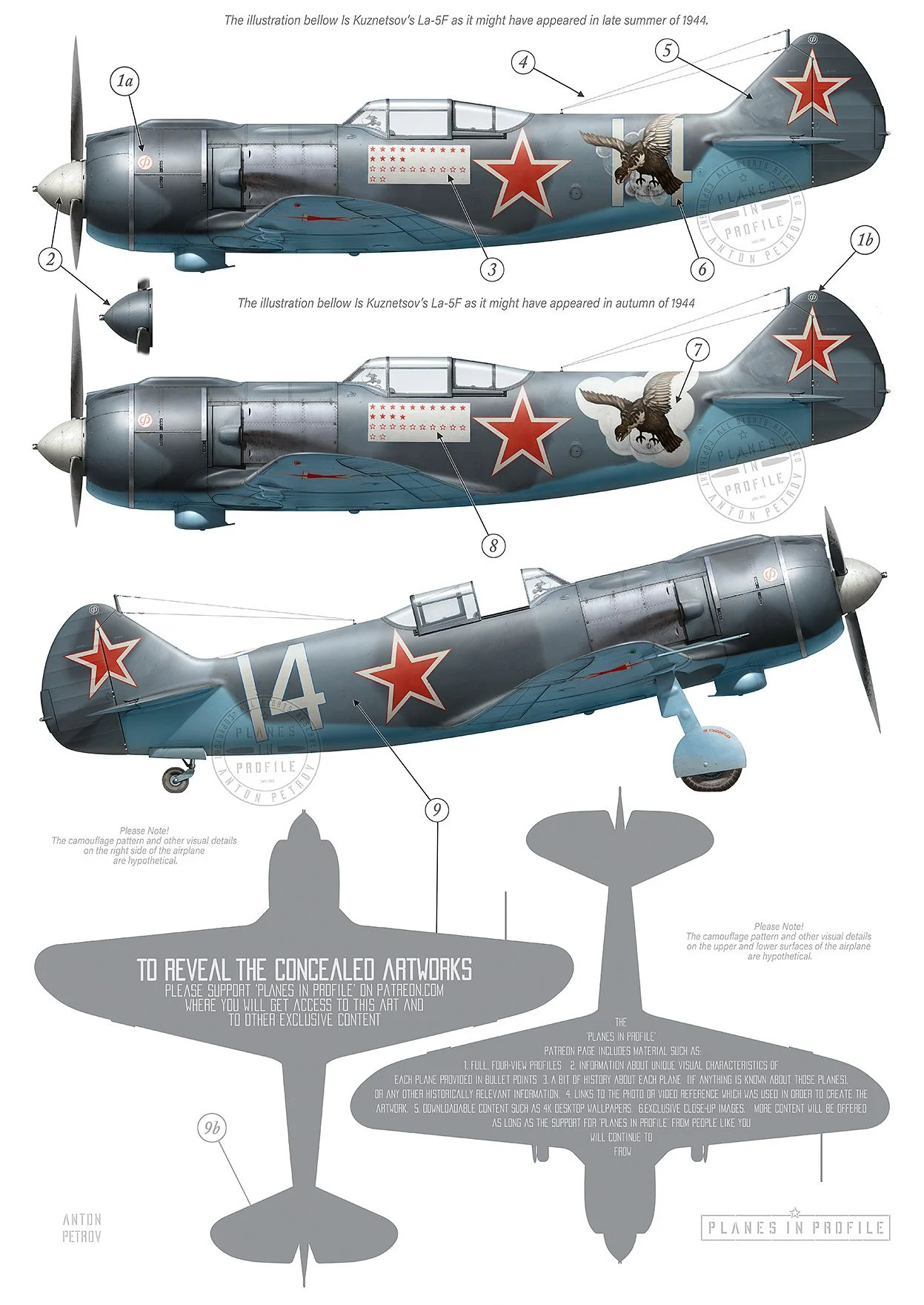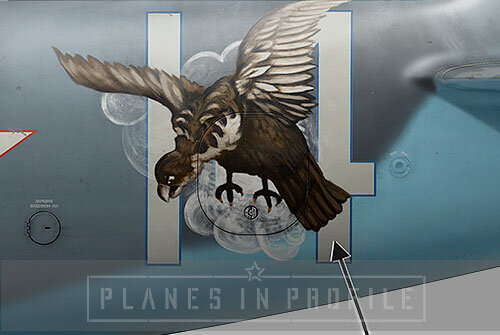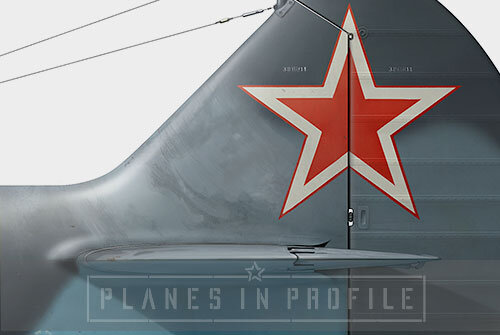Kuznetsov’s “Eagle” White-14
Lavochkin, La-5F (Type 39)
760-th IAP, 324-th IAD, 7-th Air Army, Karelian Front, 1944.
Flown by the Hero of the Soviet Union, major Nikolay Aleksandrovich Kuznetsov
Nikolay Kuznetsov was a fighter pilot of high caliber, a commander of a flight in the 147-th IAP at the outbreak of the Great Patriotic War, a commander of a squadron in the 760-th IAP from January 1942, the head of the air-shooting service of the 760-th regiment from August 1942 and an assistant commander of that service in 760-th and then 195-th IAP. A recipient of various medals including ‘Order of Lenin’ (Twice) , ‘Order of the Red Banner’ (three times) and a title of the ‘Hero of the Soviet Union’ along with a ‘Golden star’ medal. His award list stated:
“On the fronts of the Patriotic War from 22-nd of June 1941 he proved himself to be a capable, tactically competent, courageous, persistent and decisive officer. As a fighter pilot he perfectly mastered the technique of piloting and the technique of air combat, fully justified his appointment into fighter aviation, always looks for the air enemy, imposes a battle on him, takes the initiative in air combat into his own hands, actively attacks the enemy and comes out victorious. " [1]
Kuznetsov’s ‘White-14’ probably arrived in to 760-th IAP when the regiment was rearmed with 29 La-5 airplanes in February 1944 [2]. Until that time the regiment flew British Hurricane and American Kittyhawk airplanes. By the time the regiment received their La-5s major N. Kuznetsov already had 6 personal and 12 shared victories to his name. According to Mikhail Bykov’s book ‘All of Stalin’s Aces’ Kuznetsov scored all of his remaining victories in WW2 behind the controls of a La-5 ( presumably his ‘Eagle’ ?). [3] It’s worth noting that a website ‘Soviet Aces 1936-53’ mentions that one of those victories (most probably the last victory, or one of the last ones) was scored while flying a Yak-9 - this was supposedly the plane which was exhibited at the ‘Svirskaya Pobeda’ exhibition in late 1944. From July until October 1944, Kuznetsov was in 195-th IAP (not in 760-th IAP) so it’s possible that he flew a Yak-9 at that time since 195-th IAP was armed with Yak-9 planes.
Either way, according to M. Bykov those victories were all ‘personal’ victories and they included:
03.06.1944. 1 Me-109 Tunglake.
23.06.1944. 1 Blenheim Pogren-Kondush
23.06.1944 1 Brewster Vidlitsa airfield.
04.07.1944 1 Curtiss Salmi
01.08.1944. 1 Curtiss Vyartsilya airfield
16.08.1944. 1 Curtiss Vyartsilya airfield
16.08.1944. 1. Me-109 Kanunvaara. (I couldn’t find this location on the map)
As you will see from the list above, on the 23-rd of June Kuznetsov downed two enemy planes. It occurred in a single sortie. Issue number 137 of a newspaper called ‘За счастье Родины’ (For the happiness of the Motherland) published on 20.08.1944 gives a brief account of this battle :
‘A famed pilot of our front major Kuznetsov, in a pair with lieutenant Keduhin, was escorting a group of dive bombers (Petlyakov’s Pe-2) which were flying to bomb one of the large knots of enemy resistance. Behind the front line Kuznetsov noticed four Finnish bombers (Bristol Blenheim bombers). In a sudden attack the Soviet fighter downed one of the enemy’s machines. At this time four enemy fighters arrived to the place of battle. Kuznetsov, without losing his own bombers out of sight gained altitude and pounced on the enemy’s fighter (Brewster Buffalo fighter) downing it.’ [4]
Based on M.Bykov’s research, by the end of the war major N. Kuznetsov flew 500 sorties, engaged in 40 air battles and downed 25 enemy airplanes (13 of which were personal victories and 12 shared) [5]. 7 of those personal victories were presumably scored in Kuznetsov’s Eagle ‘White-14’ .
Noteworthy visual characteristics
The plane as it might have appeared in late summer 1944. Photo reference for it can be found on ava.org.ru, you can see one of the images by clicking HERE and another HERE
1 ) The logo is a cyrillic letter ‘F’ inclosed in a circle. The logo represents the ‘F’ modification of the La-5 variant, letting us know that this is a La-5F plane. The letter ‘F’ is derived from the word ‘Forsirovanniy’ which translates to ‘Forced/boosted’ and essentially refers to the improved ‘Supercharger’ of La-5F’s M-82F engine. (This engine also had an improved oil system to that of M-82A engine of the earlier La-5 planes). The logo usually appeared on the engine cowling (1a) and on the tip of the tail (1b). The logo on the engine cowling was usually painted in red over the top of a white circle background. In contrast, the one on the tail was painted in white directly over the camouflage colour and was usually smaller than the one on the engine cowling. These logos didn’t always appear on La-5F planes and there is a good chance that ‘White-14’ didn’t have these logos present either. I did however include them in my artwork.
2) The spinner might have been painted white or left as grey. Without seeing the photo of White-14’s spinner it’s hard to tell what colour it was. Based on the photo of a Hurricane which is allegedly from 760-th IAP, the spinner might have been white. This is consistent with Mihail Bykov’s (one of the leading researchers of Soviet aviation) artwork which shows a white spinner also.
3) The stars represent Kuznetsov’s victories. The 14 solid stars represent his personal victories and the 12 hollow stars (white with a red outline) his shared victories. As described in the ‘A Bit Of History’ section below, a book ‘All of Stalin’s Aces’ by M. Bykov shows that the last 7 out of Kuznetsov’s 14 personal victories were scored in a La-5, which means they might have been scored in ‘White-14’. It’s worth noting that not all sources agree on the amount of victories scored by Kuznetsov in WW2
a) According to photo reference we can see that the ‘victory board’ is showing 14 personal and (probably) 12 shared victories.
A website SovietAces1939-53.ru mentions that according to Kuznetsovs award list he had 14 personal and 12 shared victories by the 5-th July 1944. The website warheroes.ru also mentions that he had that many victories by July 1944.
b) The photo of a Yak-9 presented as Kuznetsov’s plane at the ‘Svirskaya Pobeda’ exhibition in late 1944, shows 14 personal and 8 shared victories. We can also read this on the paper plaque seen in the photo.
c) The website SovietAces1939-53.ru says that according to Kuznetsov’s award material by 1 October 1944 he had 16 personal and 12 shared victories. A website warheroes.ru also mentions that Kuznetsov ended the war with 16 personal and 12 shared victories.
d) According to Mikhail Bykov’s research Kuznetsov ended the war with 13 personal and 12 shared victories. Issue number 137 of a newspaper called ‘За счастье Родины’ (For the happiness of the Motherland) published on 20.08.1944 says that Kuznetsov had this many victories. (at least by Autumn 1944, from Autumn 1944 ‘till the end of the war Kuznetsov seems to not have engaged in any air battles).
4) Note the absence of an antena mast. Below are two possible options of what the antena wires arrangement might have looked like on Kuznetsov’s La-5F. Based on the photo reference it looks to me that the second arrangement (Option2) seems more likely. I have seen this arrangement in drawings of Kuznetsov’s La-5F by Miloš Veštšik and Mihail Bykov. But I haven’t actually seen this antena arrangement definitively confirmed with any photo reference. On the other hand, the antena arrangement in Option 1 is something that I have seen in photo reference before. HERE is a photo that shows this arrangement of antena wires on a La-5FN and HERE is another showing a similar one on a La-7 (?).
5) Note the uneven paint job visible on the tail in THIS photo. It’s quite possible that this is just a defect or a stain in the photo itself , but there’s also a chance that the plane was roughly painted in the area of the tail. I have included some similar brush marks in my artwork in this area to stay true to the photo reference.
6) Note the tactical number ‘14’ behind the painting of an eagle.
Unfortunately I could not find any information about the painting of the eagle on this plane. I presume that it’s an eagle and have seen/heard others refer to it as an eagle, but it could be some other bird of prey.
The plane as it might have appeared in autumn 1944. Photo reference for it can be found on ‘Soviet Aces 1936-1953’ , you can see it by clicking HERE
7) The cloud around the eagle was probably painted over the number ‘14’ sometime between August and October 1944.
8) There seems to be the same number of victory stars painted on the version of the plane with the larger cloud as well as the smaller cloud, implying that no new victories were scored before the Larger cloud was painted and according to Kuznetsov’s total number of confirmed victories it appears to be unlikely that Kuznetsov scored any victories in the plane after the painting of the ‘larger’ cloud either.
9) Because of the very limited photo reference it’s difficult to know the exact camouflage pattern on ‘White'-14’. It is most likely that it was painted in accordance with the standard Grey/Grey camouflage pattern introduced in 1943. Although the bend/angle in the demarcation line between the AMT-7 light blue and the upper greys behind the number ‘14’ is a slight deviation from the standard camouflage pattern instructions. Also, from what could be made out in the photo reference it seems that the left horizontal stabiliser (marked by ‘9b’ in the artwork above) is covered in AMT-11 entirely, without any camo pattern present.
Here are a few closeup images to help illustrate the points above. Full set of closeup images is On Patreon
FOOTNOTES
[1] Info taken from http://airaces.narod.ru/all11/kuzn_na.htm
[2] The date and the number of airplanes taken is taken from http://ava.org.ru/iap/760.htm
[3] It’s worth noting that the website ‘Soviet Aces 1936-53’ mentions that one of those victories was scored while flying a Yak-9.
[4] The original excerpt as well as another short description of this battle(in Russian) is found on: http://airaces.narod.ru/all11/kuzn_na.htm
[5] Info taken from Mikhail Bykov’s book ‘All of Stalin’s Aces’ 1936-1953’, page 637. Published by YAUZA, Moskow, 2014
LINKS TO THE REFERENCE IMAGES AND VIDEOS
http://ava.org.ru/iap/760/la5f_14-max.jpg
All the work presented on this is page is subject to updates and revisions in the light of new information which might present itself. If you have any new information relevant to this page or disagree with anything that's presented here, then please feel free to contact me through the Planes in Profile Facebook page. Thanks:)






